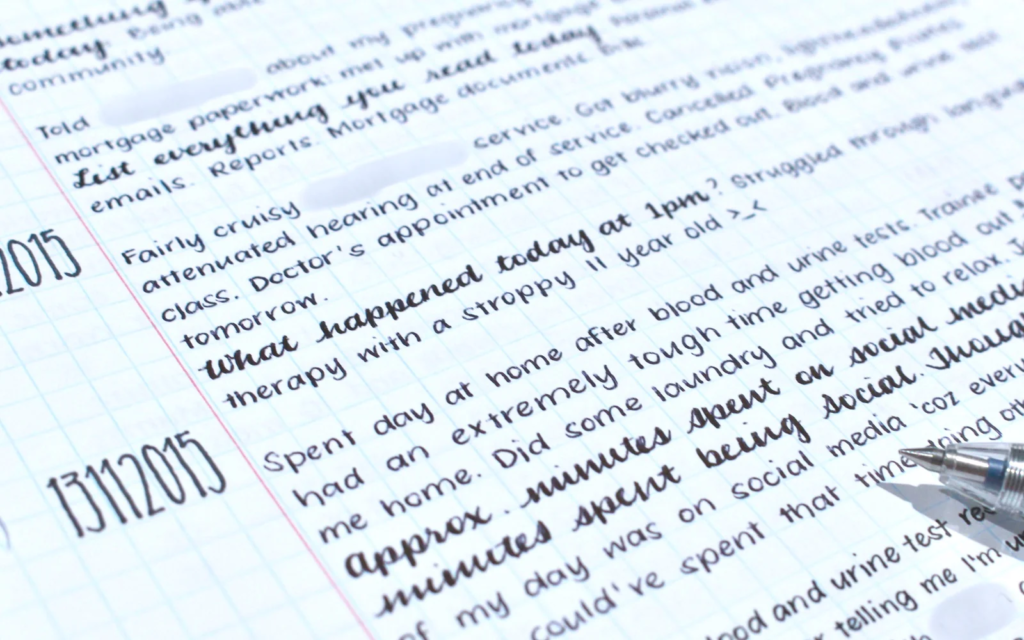Could holding a pen and writing on paper instead of relying on technology
change the way of thinking, feeling and also one’s future? These days, as technology continues to develop significantly, most people tend to rely on their electronic devices such as smartphones, laptops, and tablets for communication. Although technologies are becoming dominant, handwriting is still used as an analog method of expressing emotions among students. Handwriting has a lot of benefits not only for students but also for patients, especially those who have Parkinson’s disease. By letting them write handwritten journals every day for at least 10 minutes, they may develop self-awareness, enhance physical well-being, and overcome depression.
Before talking about the benefits of handwritten journals, it is important to understand Parkinson’s disease which occurs due to the loss of dopamine, leading to irregular brain activities and movement problems. The most common symptom of Parkinson’s disease is called “pill-rolling tremor”, a rhythmic shaking happening in patients’ hands, feet and also jaw (“Parkinson’s Disease”). Most of the daily tasks like eating, wearing, and walking could become much more difficult than before. In addition, because of their limited mobility, treatment options are also limited. The most commonly known therapeutic exercises include walking, stretching and doing yoga; however, handwriting could be a beneficial exercise that engages fine motor skills and brain-hand coordination.
First of all, writing handwritten journals that focus on self-awareness provides patients with a stronger and more stable mental state during their lifetime. Usually, patients with Parkinson’s disease face a decline in memory and disorganized daily routines, which might lead them to depression. However, when they write handwritten journals often, they enter what psychologists call “reflective mode,” where they start to detect patterns, reveal true feelings, and grasp situations more clearly (“The Healing Power of Handwriting”). Patients were able to record their spontaneous feelings so that they can also analyze their current state and reflect on their thoughts. This process enables them to realize what actions should be taken for the future, remove negative thoughts, and redirect their lives to a better organized lifestyle with an attention toward the specific goal.
Secondly, handwriting activities contribute to enhancing physical well-being. Patients with Parkinson’s disease customarily struggle to write properly due to tremor, which impairs the physical capabilities like fine motor skills. These limitations can also heavily interfere with daily activities, for instance, dressing up, drinking or performing manual tasks. However, even small practices can bring a significant difference to life. For example, by consistently practicing handwriting, patients are able to gradually strengthen the small muscles in their hands, partially improving dexterity and restoring overall hand functions. With continued practice, they will achieve better hand control, enabling them to enhance their skill of precision and more accurate handwriting, including proper sizes and spaces between words.
In addition to its physical benefits, writing a journal by hand also helps regulate emotions and overcome depression for patients who have Parkinson’s disease. Life with Parkinson’s disease would be not only physically demanding but also emotionally challenging because the condition frequently causes emotional instability, including elevated stress levels, anxiety, and sudden emotional changes. Handwritten journaling provides patients with opportunities to express their personal feelings without the need to mask their true feelings and try to satisfy social desirability. It also allows them to track their day-to-day emotional fluctuations, which makes them able to analyze their feelings plus identify sources of distress or satisfaction.
In conclusion, handwriting activities have high possibilities to help patients with Parkinson’s disease to be cured. In spite of the fact that handwriting is considered as an outdated method in modern day, it’s true that handwriting holds powerful benefits on both body and brain. Through many experiments conducted before, it proved that this simple act could sustain a positive mindset, regulate stress, and stimulate the tiny muscles in hand that are essential for daily functioning. Therefore, daily handwriting journaling could serve as one of the most efficient methods to enhance mental health, improve physical functioning and foster emotional balance.

Works Cited
“The Healing Power of Handwriting: How Putting Pen to Paper Transforms Your Mental Wellness – Custom Gratitude Journals for Mental Wellness.” Pockitudes, PockitudesTM, 8 June 2025,
www.pockitudes.com/blog/the-healing-power-of-handwriting-how-putting-pen-to-paper-transforms-your-mental-wellness?srsltid=AfmBOoqVUt5BimYueQx1w0SqDcG51ZTqAKE8THycefzG9jSCDqm0jlhE.
Lambert, Jonathan. “Why Writing by Hand Beats Typing for Thinking and Learning.” NPR, NPR, 11 May 2024, www.npr.org/sections/health-shots/2024/05/11/1250529661/handwriting-cursive-typing-schools-learning-brain.
Moawad, Heidi. “Parkinson’s Disease Facts: What You Need to Know.” Verywell Health, Verywell Health, 17 June 2025, www.verywellhealth.com/parkinsons-disease-facts-5324573.
By. James Yoon

